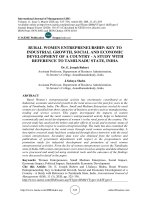Economic growth and economic development 293
Bạn đang xem bản rút gọn của tài liệu. Xem và tải ngay bản đầy đủ của tài liệu tại đây (115.14 KB, 1 trang )
Introduction to Modern Economic Growth
In view of Assumption 6.3 (that G is convex valued) yα = αy 0 + (1 − α) y 00 ∈ G(xα ),
so that
T V (xα ) ≥ U(xα , yα ) + βV (yα ),
> α [U (x0 , y 0 ) + βV (y 0 )]
+(1 − α)[U (x00 , y 00 ) + βV (y 00 )]
= αT V (x0 ) + (1 − α)T V (x00 ),
where the first line follows by the fact that yα ∈ G (xα ) is not necessarily the
maximizer. The second line uses Assumption 6.3 (strict concavity of U), and the
third line is simply the definition introduced in (6.16). This argument implies that
for any V ∈ C0 (X), T V is strictly concave, thus T [C0 (X)] ⊂ C00 (X). Then Theorem
6.8 implies that the unique fixed point V ∗ is in C00 (X), and hence it is strictly
concave.
Ô
proof of Corollary 6.1. Assumption 6.3 implies that U (x, y) is concave in
y, and under this assumption, Theorem 6.4 established that V (y) is strictly concave
in y. The sum of a concave function and a strictly concave function is strictly
concave, thus the right hand side of Problem A2 is strictly concave in y. Therefore,
combined with the fact that G (x) is convex for each x ∈ X (again Assumption
6.3), there exists a unique maximizer y ∈ G (x) for each x ∈ X. This implies that
the policy correspondence Π (x) is single-valued, thus a function, and can thus be
expressed as π (x). Since Π (x) is upper hemi-continuous as observed above, so is
π(x). Since an upper hemi-continuous function is continuous, the corollary follows.
Ô
proof of Theorem 6.5. The proof again follows from Theorem 6.8. Let
0
C (X) ⊂ C(X) be the set of bounded, continuous, nondecreasing functions on X,
and let C00 (X) ⊂ C0 (X) be the set of strictly increasing functions. Since C0 (X)
is a closed subset of the complete metric space C(X), Theorem 6.8 implies that
if T [C0 (X)] ⊂ C00 (X), then the fixed point to (6.15), i.e., V , is in C00 (X), and
therefore, it is a strictly increasing function. To see that this is the case, consider
any V ∈ C0 (X), i.e., any nondecreasing function. In view of Assumption 6.4,
279









